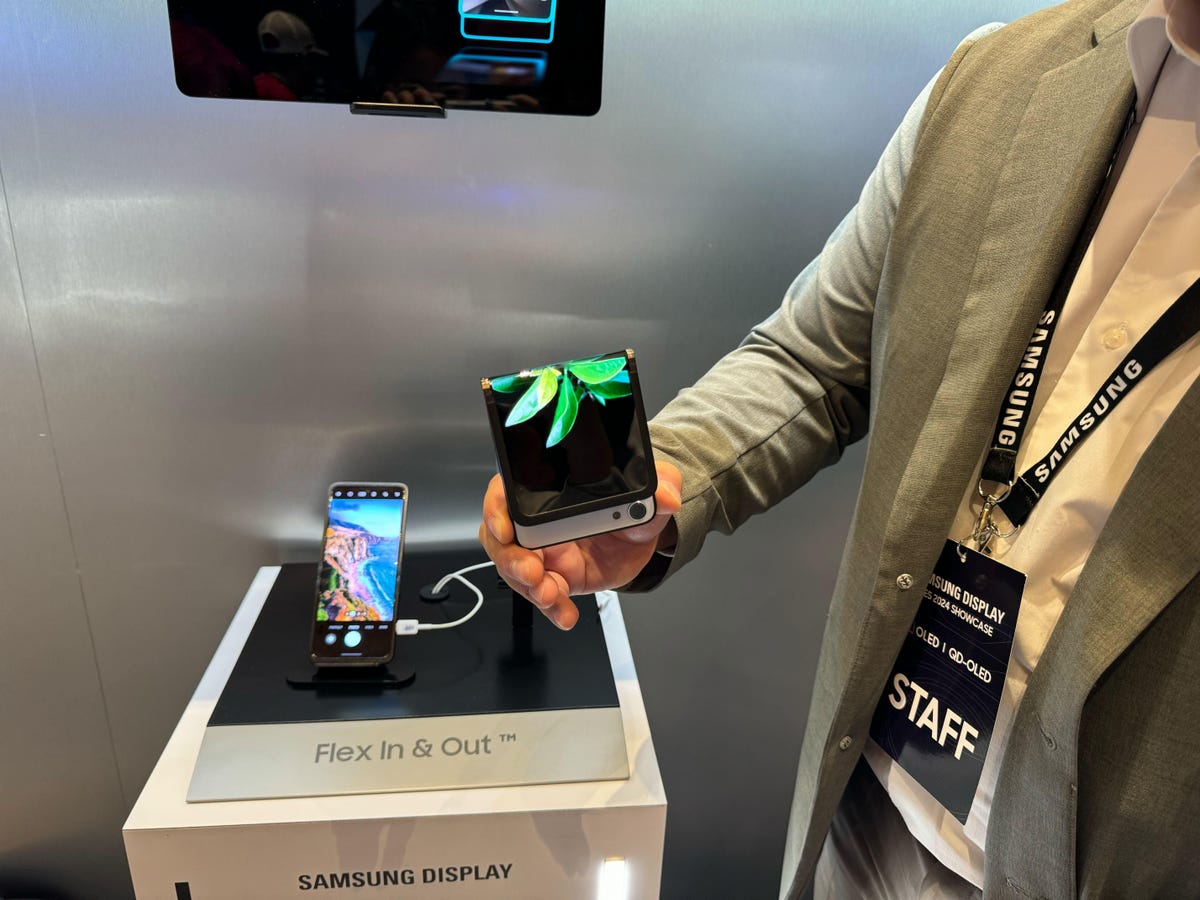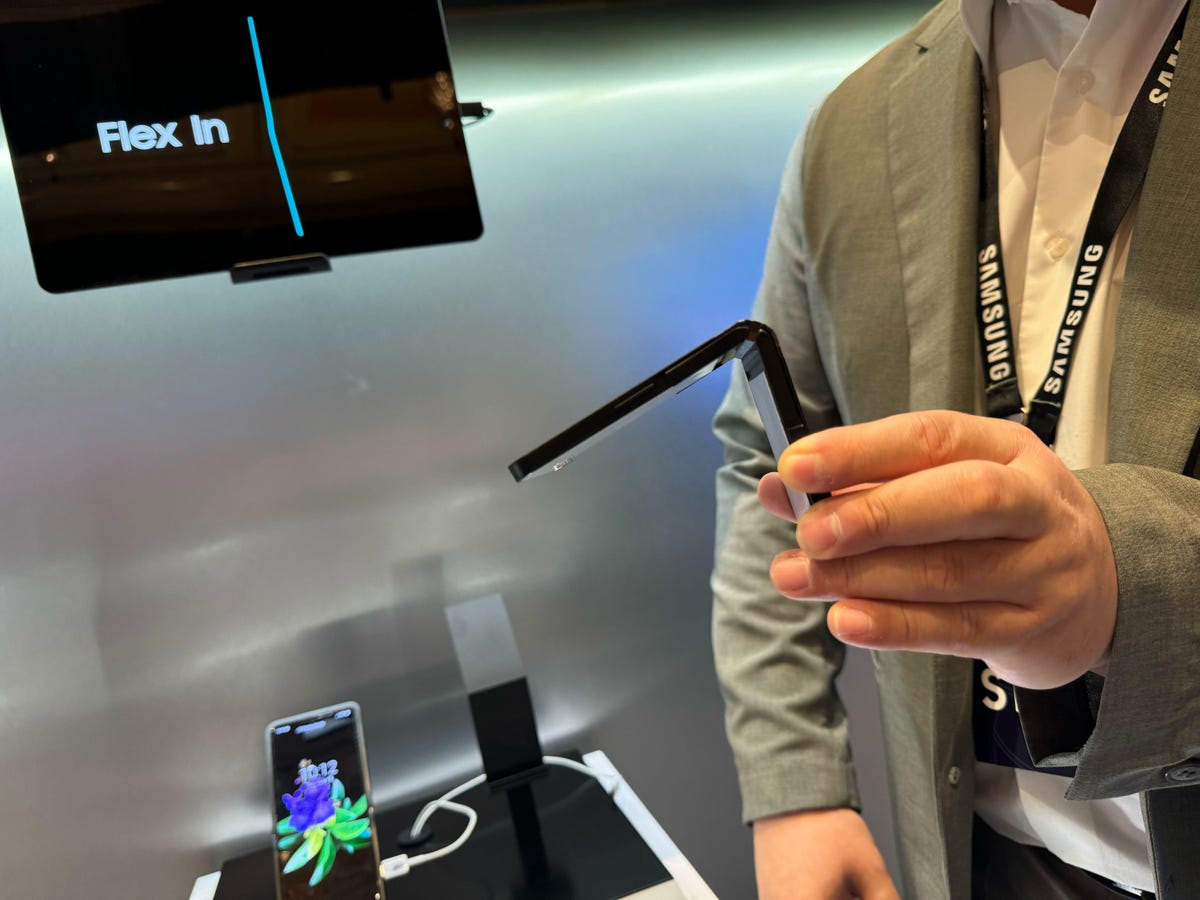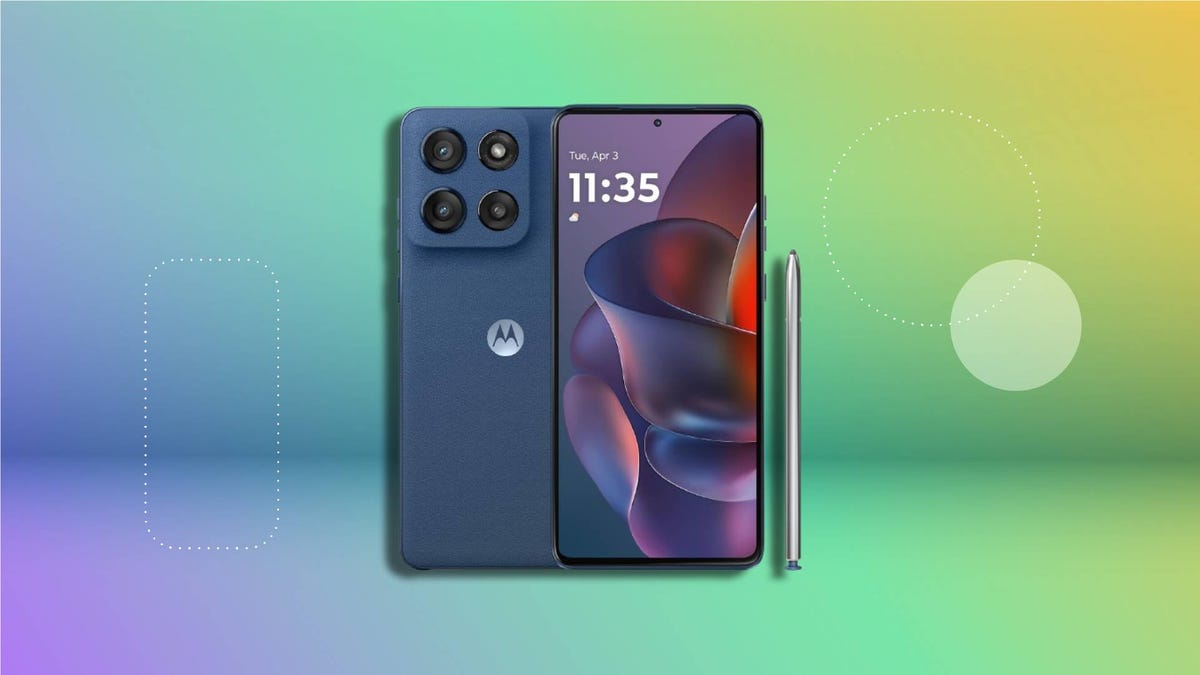Technologies
Samsung’s Flip Phone Concept Gives You a Dual-Folding Experience
Samsung’s Flex In & Out Flip concept is like a Galaxy Z Flip you can fold in both directions.

At CES 2024, I watched a Samsung representative open the shiny Flex In & Out Flip concept device and fold it in both directions. Unlike the Galaxy Z Flip 5 and other flip phones you can buy today, it folds completely backwards so that you use the phone’s 6.7-inch screen even when the device is shut.
I wasn’t allowed to bend the Flex In & Out Flip concept device myself, but it’s a standout concept from Samsung’s Display team that could provide a glimpse at where foldables are heading. Samsung Display’s entire booth was full of foldable concepts in all shapes and sizes, and it’s all part of an ongoing effort to make devices that roll, flex, bend, fold fit more interestingly into our lives.
When the Flex In & Out Flip is bent backwards, one side of the device is shorter than the other, to avoid covering the camera. The larger side was big enough to show several icons in the phone’s quick settings menu, media playback controls and the time and battery level. The phone was running a looped demo video rather than actual software, but the simulation still provided a sense of how the user interface would adapt to the phone’s movements.
Read more: The Most Eye-Catching Mobile Tech at CES 2024
The low-hanging fruit would be a more flexible Samsung Galaxy flip phone. That said, the Flex In & Out Flip is only a concept for now, so there’s no indication that the technology will ever show up in a real product just yet.
But it shows that Samsung may be thinking about ways to make its nearly 4-year-old flip phone line more versatile and potentially more useful. Samsung has shown concepts of its larger book-shaped Galaxy Z Fold-like design that can bend all the way backwards, but this is the first time it’s showing a flip phone with that capability publicly.

Read more: Best Flip Phones
Based on the limited time I’ve had to check out the concept so far, it seems like the biggest benefit would be having one screen that can be used consistently whether the device is opened or closed. The Galaxy Z Flip 5 has a reasonably large external screen, making it much more useful for using apps and reading notifications than the Galaxy Z Flip 4 and other older models. But since it’s a separate screen, you still have to customize it to your liking and choose which apps you’d like to use on it.
I’m curious about whether using the same screen on the inside and outside could provide a more consistent experience. However, since the Flex In & Out Flip is just a concept and not a product, who knows whether I’ll ever get that answer.

The company also says it’s tested the concept’s durability by folding it in extreme temperatures ranging from -20 degrees Celsius to 60 degrees Celsius and bouncing basketballs on its foldable panels. Over the summer, CNET got a closer look at how Samsung tests the durability of its foldable phones on a visit to the company’s headquarters in South Korea.

Samsung also showed several other flexible and foldable display concepts during CES, including the Flex Liple, another flip phone prototype with a display that curves around its top edge. There was also the Rollable Flex, which can expand its screen up to five times in size by unraveling like a scroll, and the company also showed new high resolution displays for mixed reality headsets.
The Galaxy Z Flip 5 and the Motorola Razr Plus, which has a similarly spacious front screen, both show the promise of having a phone with a secondary screen that can fit in the palm of your hand. The Flex In & Out Flip concept, should it ever surface in a product, feels like it could be another step in that direction.
Technologies
Call-Recording App Neon Disappeared Abruptly. Now It’s Back for Another Try
The app stirred privacy and security questions offering to pay people for recordings of their phone calls to train AI models. A security flaw didn’t help.

In September, the Neon app briefly became a sensation on app download charts by promising to pay users for recording and sharing their phone calls. Then it abruptly went offline amid controversy over its security practices, privacy protections and payment structure.
More than a month later, Neon has returned to the iOS App Store and the Google Play Store, and the New York-based companyfollowed up a few days later with a new payout formula. Its founder, Alex Kiam, says the security issues have been resolved, but without offering much detail.
How far the company has progressed remains unclear. An email from Kiam to users on Thursday was sprinkled with phrasing like «while we prepare this new version of the app» and «once the new version of the app launches.»
In our own tests, we were unable to get the new version of Neon to work on iOS. A screen that asks to verify a phone number for signup didn’t trigger a phone call as expected.
Neon sells the recordings of user calls to companies training AI models, which are hungry for real-world input, such as how people speak conversationally. The company says it anonymizes call information.
Privacy experts CNET spoke to warned against using the app in its previous incarnation due to concerns over call consent laws, and also noted that AI could infer user information or identities even if call data is anonymized.
Don’t miss any of our unbiased tech content and lab-based reviews. Add CNET as a preferred Google source.
What’s changed with the Neon app?
Shortly after Neon soared on the app store charts, the news site TechCrunch discovered a security flaw that allowed people to access calls from other users, including transcripts and metadata about the calls. After the app went dark, Kiam said that the company would address the issue and that the app would return with a bonus for users.
At that time, users of the app could call anyone and get paid. According to the company, only the app user’s side of the call was sold, since in some states, it’s not legal to record a conversation without permission.
The new version is attempting to circumvent these state issues with a new app-to-app setup: Both parties to the call must have the Neon app installed, essentially making it an opt-in service. Only calls from one Neon user to another Neon user are paid, meaning both people on the call have signed up with the company.
In his email on Thursday, Kiam list details of the updated formula for payments. It starts out with pay to users of 20 cents per minute for the first 20 minutes of call time per day, to a maximum of $4 a day. The plan also describes payments for referrals to the app, up to $50 a day from referral earnings — as long as users «don’t try to game the system with fake calls» — with the potential for a higher daily maximum for users «who have referred a lot of people.»
That is, earning potential is based largely on users getting other people to sign up and use the app.
Users posting comments on the Google Play Store have given the company low ratings, complaining that referral rates have dropped to as low as $1 and that call payment rates may be as low as 5 cents per minute. The app currently has a rating of 2.2 stars out of 5 on the Google Play Store and 2.7 stars out of 5 on the App Store for iOS.
Security concerns with Neon
When Neon went offline, it was with the expectation that the company would fix the vulnerability that could have allowed someone to access calls from other users.
Kiam told CNET via email that the company «engaged with» three cybersecurity firms after the security hole was found and engaged a contractor to perform a code review to address security concerns. He said that Neon later hired that contractor as its chief technology officer. He didn’t name the contractor, but said the person is «the former CTO of a reasonably large tech company who has 20 years of experience building secure platforms.»
Neon addressed the underlying issue TechCrunch found, Kiam said, and didn’t discover any evidence of «malicious actors» accessing its database. He didn’t elaborate on how the company addressed that issue.
The delay in bringing Neon back to iOS was not intentional, he said. «I wanted to bring Neon back quickly, but it was important that we did this right.»
Neon’s updated terms of service
As part of its relaunch, Neon has waived the $30-per-day limit on pending payouts. Kiam said the company plans «a future pleasant surprise» for those who were already using the app.
According to the updated terms of service from Nov. 3, those who sign up for the app agree that Neon can «sell and offer for sale» call recordings «for the purpose of developing, training, testing, and improving machine learning models, artificial intelligence tools and systems, and related technologies.»
There is still concerning language regarding Neon’s rights and licenses that grant the company the authority to publicly display, reproduce and distribute call recordings «in any media formats and through any media channels.»
The appeal of earning a few extra bucks for very little effort is understandable, especially when many people are worried about money amid tech industry layoffs, the US government shutdown and the suspension of services like the SNAP food assistance program.
Still, security concerns, the ethics of turning over personal conversations to AI companies, the lack of clarity about payments and complaints in user reviews should give users pause.
In an interview with CNET in early October, Kiam said his company was overwhelmed by the sudden popularity of Neon, but not completely surprised.
«I expected things to grow pretty quickly because … we’re getting people money for something that they would do anyway,» Kiam said. «We felt confident that there was real demand for something like this.»
Technologies
Upgrade Your Mobile Gaming Experience With This Best-Ever Price on the GameSir G8 Plus
At just $72, this deal saves you $28 on a great controller for gaming on the go.

Mobile gaming has come in leaps and bounds in recent years, and some of the best games can be found on your phone. But touchscreens aren’t suited to all kinds of games, and that’s why a controller is a good pickup for any mobile gamer. The GameSir G8 Plus works with phones and tablets, and right now it’s yours for its lowest-ever price of just $72. That’s down $28 from its original price and about 10% off the price we’ve been seeing lately.
This deal doesn’t ask you to enter any codes or clip any coupons, but you should be aware of its limited-time label. Stocks could run dry at any time, so make sure to order your new controller soon to avoid missing out.
Hey, did you know? CNET Deals texts are free, easy and save you money.
The GameSir G8 Plus supports both Android and iOS, and connects to your device using Bluetooth. You place your phone or tablet into the controller itself, creating a Nintendo Switch-like experience.
The controller itself has Hall Effect joysticks to avoid age-old issues like stick drift, and the six-axis motion-sensing technology is useful for games that support motion controls. You can even connect this controller to your PC via a USB-C cable and play there, too.
Our reviewer, Jason Cockerham, thinks this controller is worth grabbing if you don’t mind dealing with its software. He goes into more detail in his full review, but notes that, «If you don’t care much about the lackluster app, then the G8 Plus really is a solid controller. It feels great, responds well, and has respectable battery life.» He also added that, «It’s a great controller, even for $100.» And now that it’s down to $72, it’s a much better value.
Don’t miss any of our unbiased tech content and lab-based reviews. Add CNET as a preferred Google source.
Why this deal matters
Sometimes it can be difficult to find time to fire up a console or PC, but that doesn’t have to mean you can’t play. Mobile gaming is a great way to game when you might otherwise not be able to, and this controller gives you a familiar gaming feel on the go — and at an excellent price, too.
Join Our Daily Deals Text Group!
Get hand-picked deals from CNET shopping experts straight to your phone.
By signing up, you confirm you are 16+ and agree to receive recurring marketing messages at the phone number provided. Consent is not a condition of purchase. Reply STOP to unsubscribe. Msg & data rates may apply. View our Privacy Policy and Terms of Use.
Technologies
The Top-Rated Motorola 2025 G Stylus Just Hit $300, a New Low for the Stylus-First Android
This 8GB/256GB unlocked model is 25% off at Amazon — with a built-in stylus, fast charging and Android 15.

Motorola’s G Stylus line has always leaned into utility, and the 2025 version adds a few thoughtful upgrades without pushing the price too far. It’s one of the few phones in its class with a built-in stylus, and it now supports Android 15, AI features and faster charging. If you’re looking for a mid-range phone that doesn’t feel stripped down, this one’s worth a look.
Amazon has dropped the 2025 Moto G Stylus to $300, a $100 discount off its $400 list price — that’s 25% off. Grab the deal while it lasts. It’s the lowest price we’ve seen for this configuration, which includes 8GB of RAM and 256GB of storage. For comparison, the 2024 model is currently available for $200 at Best Buy; however, it lacks the newer chip and faster charging capabilities.
The 2025 G Stylus features a 6.7-inch pOLED display with a 120Hz refresh rate and Dolby Atmos support. A Snapdragon processor powers it, runs Android 15 and includes a 50 MP primary camera with AI enhancements. The stylus is built in, and the phone supports sketching, note-taking and photo markup without requiring a separate accessory.
Hey, did you know? CNET Deals texts are free, easy and save you money.
Charging is fast — Motorola says you can get “power for the day” in just 15 minutes. However, the 68W TurboPower charger is sold separately. The phone also includes IP68 water resistance, a vegan leather finish and MIL-STD-810H durability testing.
In CNET’s hands-on coverage, the phone was praised for bringing AI features to a lower price tier. It’s also been called “the fastest charging phone under $400” — a rare distinction in this category.
For more picks, check out our best Android phones and top budget phone deals.
MOBILE DEALS OF THE WEEK
-
$650 (save $60)
-
$499 (save $300)
-
$551 (save $50)
-
$250 (save $300)
Why this deal matters
Stylus-equipped phones are rare in the midrange category. The 2025 Moto G Stylus adds fast charging, AI features and a premium display — all for $300. With 256GB of storage and Android 15, it’s a well-rounded option for phone users who want flexibility without overspending.
Join Our Daily Deals Text Group!
Get hand-picked deals from CNET shopping experts straight to your phone.
By signing up, you confirm you are 16+ and agree to receive recurring marketing messages at the phone number provided. Consent is not a condition of purchase. Reply STOP to unsubscribe. Msg & data rates may apply. View our Privacy Policy and Terms of Use.
-

 Technologies3 года ago
Technologies3 года agoTech Companies Need to Be Held Accountable for Security, Experts Say
-

 Technologies3 года ago
Technologies3 года agoBest Handheld Game Console in 2023
-

 Technologies3 года ago
Technologies3 года agoTighten Up Your VR Game With the Best Head Straps for Quest 2
-

 Technologies4 года ago
Technologies4 года agoVerum, Wickr and Threema: next generation secured messengers
-

 Technologies4 года ago
Technologies4 года agoBlack Friday 2021: The best deals on TVs, headphones, kitchenware, and more
-

 Technologies4 года ago
Technologies4 года agoGoogle to require vaccinations as Silicon Valley rethinks return-to-office policies
-

 Technologies4 года ago
Technologies4 года agoOlivia Harlan Dekker for Verum Messenger
-

 Technologies4 года ago
Technologies4 года agoiPhone 13 event: How to watch Apple’s big announcement tomorrow



